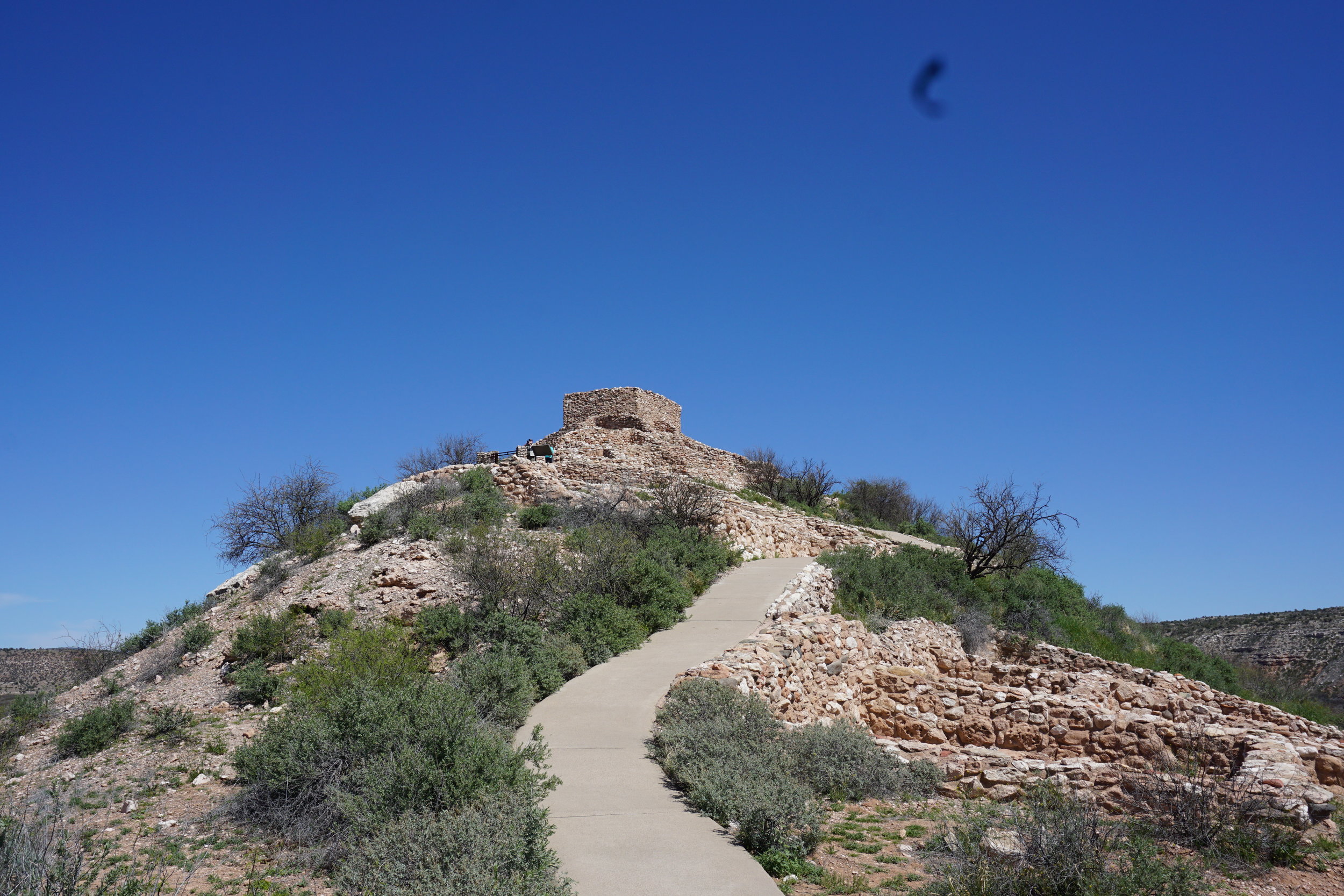Arizona Spring '19 (Continued)
We headed out too early to get to our trip on the Verde Canyon Rail Road so we went to Tuzigoot National Monument to see how much more had been done in restoration since our last stop there many years ago. When we first went there, while in AZ for spring training, you could actually go into the ruins. Well, as visitors increased and a nice visitor center opened, access has been constrained. Places like this can get loved to death, not to mention the thoughtless morons that trash such places. The site is near the Verde river, a historical source of constant water, supporting civilizations for thousands of years. The site was overlooked for decades and the surrounding area was used for settling ponds for the copper works in Clarkdale. A few years ago they were restored, somewhat, and now are shallow pans with desert grasses repairing the damage from mining.
We had an extra day so we scheduled a tour of the Verde River canyon on the Verde Canyon Rail Road. It’s a four hour trip from Clarkdale to a ranch on the site of an old town, Perkinsville, which is now a private ranch. The railroad has permission to use the tracks on the private property, but there are no services for tourists. You must get food and water at the Clarkdale Station, although there are snacks and drinks available on the train. There are open flatbed rail cars, covered for protection from direct overhead sun, that are perfect for photography and each one has a guide that points out specific items and land forms of interest. It is a beautiful ride, but one I’d don’t think I’d want to take in the hot seasons. The day we went temps were in the 70’s, quite pleasant and jackets helped against the wind. https://verdecanyonrr.com/

It’s before schools are out so you get a lot of old folks sightseeing. There was a busload that we had to wait for.



Sinagua dwellings on the cliffs above the river

Sinagua structure, probably a grain storage site








Black Mountain. It’s top is covered in basalt from volcanic eruptions that did not erode as easily as the other rock formations.


Rounding a curve I was able to catch a shot of the locomotives


You are often above the river, traveling along the canyon walls.




















Sycamore trees in the river bottom. They are the last to leaf out at this altitude. When we saw them elsewhere days earlier we stared calling them ghost trees because of the white color











There are some ranches along the river. Access is not easy. The road on the east side of the river only goes about 1/2 way as far as the railroad.











Train going over the SOB Canyon. It stands for Superintendent of Bridges, sorry….



Shadow catching



On the road back to Sun City we passed signs for Arcosanti, an artists’ colony set in the desert north of the Valley of the Sun. The exit where this is accessed from was the one we took to get to Jerome. We decided to do a day-trip to check it out, and we did. It’s definitely a working artists colony. It was founded by Paolo Soleri, an Italian architect from Turin who emigrated to the US at the end of WW II and took up apprenticeship with Frank Lloyd Wright at Taliesin West, in Scotsdale. He developed the theory of “arcology”, integrating architecture with archaeology. He founded Cosanti, in north Scotsdale, for students of architecture at the University of Arizona where he used earth forms to build structures, which included his “Earth House” and foundry and kiln for casting bronzes and ceramics. https://arcosanti.org/visit/cosanti/
You can tour Arcosanti but the site is pretty small. We spent about 30 minutes there and purchased one of the bells cast there. I’d recommend visiting the site. Paolo used the earth for his concrete forms, sculpting the ground for shape and incising designs in the dirt that would be seen on the inside of the concrete shells created. Arcosanti piqued our interest and the next day we traveled to Cosanti, his workshop and school in Scotsdale, close to Wright’s Taliesin West. Definitely this is worth a stop for anyone visiting the Phoenix area. The ingenuity and process used to create the structures at Cosanti are amazing. And, there are the sculptures and castings done there to catch your eye, and wallet. Take one of the morning tours. They both include seeing casting in progress at the foundry.



The building was created by casting panels of consistent size and shape on the site. All the concrete was made on site.


The Aqua Fria runs through the property. It ain’t much here

This is the inside of the “gift shop” at Cosanti. Note the free flowing shapes of the structural elements.

The roof panels were formed by sculpting the ground and then using rebar and concrete to create the shells.


The forms on the underside were created by digging channels on the ground surface after the general form was done.

One of the sculptures. No way we could afford this one, let alone have a place to hang it.









Soleri’s studio


The bronze foundry

















The residence spaces for workers and artists.

Artists do apprenticeships here and live on-site







There’s a pool for the residents







This is the “Earth House”, Soleri’s first construction utilizing the ground for temperature control. This started his fame.



Well, this is it until I set aside some more time to cover some more. Still to come: Copper Horse Vineyard and the Chiricahua National Monument, and another “ghost town” Crown King, an old silver mining town Northwest of Phoenix about 30 miles of dirt/gravel road back into the mountains.
So, Ciao for now.








